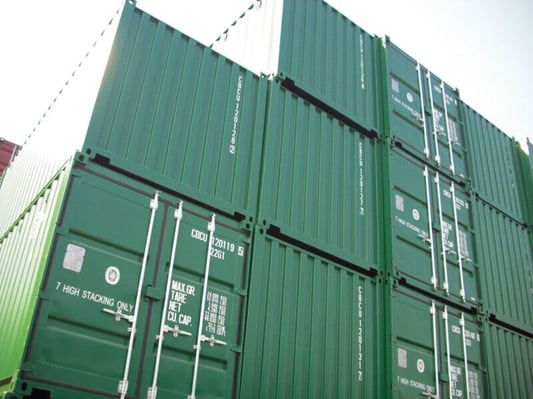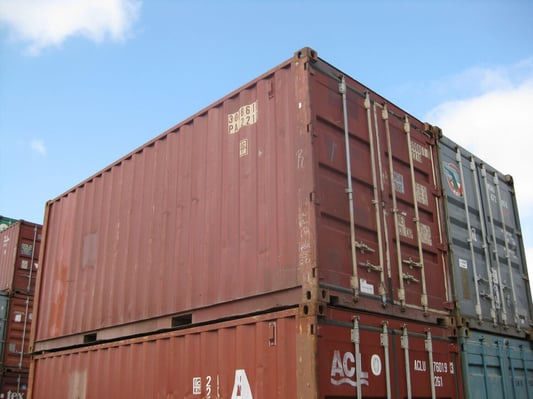How To Stack Containers
Shipping containers have revolutionized the storage and shipment industry — and they are great for stacking. Like adult Legos, you can put them together in combinations that fit your needs. But there are a few things to consider when planning your container stacking to keep the process safe, efficient, and fast.** (**See end of blog) With years of experience in the container industry, Super Cubes is your go-to source on all things shipping and knows the essential stacking tips. Keep reading below to learn how to stack containers confidently and fit every space with ease.

Before You Start Stacking Shipping Containers…
Keep in mind the quality of your container. When you are stacking containers, you want to make sure the bottom container is structurally sound enough to handle stacking. Generally speaking, cargo-worthy and one-trip containers will be fine for stacking and you theoretically should stack them 9 high, but that does depend on the surface and anchoring you are using.
For wind- and water-tight containers, you will want to inspect the cross-members and corner posts to make sure that they have not been damaged or worn out and should be limited to only 2-3 high. Again, keep in mind what surface you are using. By definition, wind- and water-tight containers are not structurally sound enough to be stacked like cargo-worthy containers.
What’s the Best Way to Stack Your Shipping Container?
Corner-post to corner-post. Containers are designed for stacking on ships. On ships, they stack like-sized containers one right on top of another, lining up corner-post to corner-post. If you look carefully, you’ll see that the corner-posts sit just a little lower than the bottom of the container and just a little higher than the top of the container. The corner-posts and flooring of the container are designed to bear the weight of the container and the container(s) above it. So you want to do the same with your stacking. If you are stacking 2x20’ containers and 1x40’ container, be sure that the 20-footers are on the bottom so all four corner-posts of the 40’ container have corner-posts to set on. If you do the reverse, the 20’ corner posts will not have proper support and the 20’s could fall through the roof of the 40’. If your design does not allow for this, then build in supports for the corner-posts.


How to Keep Shipping Containers Secure
Lock containers together. When containers are loaded on ships, they are lashed together. This prevents containers from slipping around while they are in transit on the ocean. If you want to create more stability for your stacked containers, you can get twist locks to lock your containers together as well. Twist locks are mechanical devices that secure shipping containers by connecting the corners. They are a minor investment for a big peace of mind.
How Do You Successfully Stack Your Containers?
Knowing how to do the actual stacking is essential. Having a plan in place is nice, but how do you DO it? Generally speaking, you will need a forklift or crane to set the containers in place. THe trucks that set containers down cannot physically stack them. Most simply slide the container off the truck, or else they set it off the side of the truck. However, there are some special forklifts meant to pick up containers. Container forklifts pick them up from above and can handle both 20-foot shipping containers and 40-foot shipping containers. Considering how much weight can be in them, this is a huge feat.
What Equipment is Necessary for Stacking Containers?
There are two major ways to stack shipping containers: Forklifts and cranes.
1. Forklifts
Before operating a forklift with forks to move your shipping containers, there are some areas that need to be checked for a few precise details**. Here’s what the proper forklift for stacking shipping containers should include:
- The forklift pockets on 20' containers are 69" from the inside of one pocket to the inside of the other pocket. The forklift needs to be able to spread that far apart.
- If the forklift cannot manage that, then the forks (or fork extensions) need to be at least 8' long so the forklift can pick the container up from underneath. But if the forks are not long enough, they will poke through the floor of the container.
- 8’ long forks are needed for 40' containers since most used 40’ containers and some one-trip 40’ containers do not have forklift pockets.
- Forklifts need enough strength to lift 20' containers weighing 5,000 pounds and 40’s weighing just shy of 10,000 pounds.
As in all larger projects, you want to have someone familiar with the limitations of the forklift inspect the project before starting any work. They need to make sure other factors are being addressed (level ground, other environmental concerns, etc.) to be sure that everything goes safely and smoothly. It is important to have a trained forklift operator using the forklift.
2. Cranes
If your forklift cannot handle the project, you may have to hire a crane to stack the containers. Ideal for higher stacks that a forklift can’t reach or for traversing over difficult terrain, they are a valiant substitute for a traditional shipping container forklift.
Our recommendation is to find the closest crane and material handling company to the site to help you out as they generally charge for travel, set-up and work time. They can help you find the right equipment to handle the job. Reputable crane operators will ask you many questions upfront to make sure they understand the job before they give you a rate.
Where to Buy Shipping Containers for Sale for Stacking or Shipping
If you’ve read this far, chances are you already have a shipping container that requires stacking. But if you need to find quality shipping containers that hold up to the rigors of shipping, our team at Super Cubes can help you find the right 20-foot shipping containers and 40-foot shipping containers for the job. Reach out to us today to get matched with your best shipping container solution.
Shipping Container Stacking Checklist
This is a lot of information, so we’re compiling everything into a neat checklist to get you started.** Here’s a summary of the steps you can take to learn how to stack containers and take your shipping to the next level.
- Ensure your shipping container quality matches your stacking needs.
- Design a shipping container stacking layout and ensure the proper support is available before starting to stack.
- Prepare the stacking site with the proper foundation and tools at your disposal.
- Determine whether you need a forklift or crane to get the job done, and plan to have both readily available if you need them.
- Obtain the required permits and get inspections done as necessary.
- Implement safety measures to keep your team protected during the stacking process.
Hopefully, this should help you complete your stacking securely, safely, and in record time.**
Have fun! Be safe! Start stacking!
*Super Cubes does not take responsibility for the safety of projects like this. These are meant as guidelines, not an exhaustive list of things to consider before taking on a project like this. But hopefully, this has helped you with the initial planning stages of your project.
Super Cubes is a family-owned business located in Minneapolis, MN, that provides containers anywhere in the continental US. We offer personalized service for individuals and businesses, providing high-quality containers at competitive prices. With nationwide facilities, we can modify and deliver containers close to you. Contact our experienced team for your next container project.
August 9, 2024

